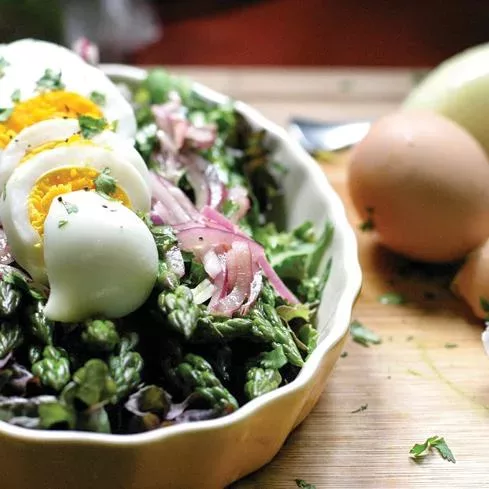Ingredients
For the Olive Oil Vinaigrette:
- 1 1/2 tablespoons extra virgin olive oil
- 1 tablespoon apple cider vinegar
- 1 teaspoon honey
- 1/4 teaspoon sea salt
- 1/4 medium red onion, thinly sliced
For the Salad:
- 2 pasture-raised fresh eggs
- 1 bunch asparagus
- fresh cilantro or parsley, chopped
- 2 lettuce leaves (garnish)
Method
- Mix together the olive oil, vinegar, honey, and sea salt until the salt is dissolved.Add the thinly sliced red onion and mix well. Allow the onions to marinate in the dressing for about 15 minutes.
- Meanwhile, fill a small saucepan with fresh water and bring to a boil. Gently pierce the “butt” ends of the egg with a push pin or small needle. You want to make sure not to push in too far, just enough to pierce a hole in the shell. Gently add the eggs to the boiling water and reduce the heat to medium. Allow the eggs to simmer uncovered for 10 minutes. Once the 10 minutes are up, quickly rinse the eggs under cold water and set aside on a dry towel to cool further.
- While the eggs are boiling, place a steamer basket into a large pot and fill with water just so the water is under the basket. Gently bend each asparagus spear at the bottom end until it naturally snaps. Discard the ends in the compost or save for a future asparagus soup. Place the asparagus into the steamer basket, cover the pot, and bring the water to a boil. Cook for about 3–5 minutes or until the asparagus is bright green and tender. Be careful not to overcook the asparagus, otherwise it will turn green-brown. Once the asparagus has reached optimal color and tenderness, quickly rinse the asparagus in cold, running water for about 30 seconds to stop the cooking process.
- Salad Assembly: Place the lettuce leaves in a serving dish and top with steamed asparagus. Evenly pour the vinaigrette with the marinated onions over the asparagus and top with the sliced hard-boiled eggs. Sprinkle the eggs with chopped cilantro or parsley, freshly ground pepper, and a bit of sea salt. Serve immediately.







